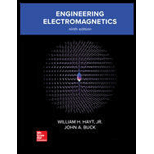
Engineering Electromagnetics
9th Edition
ISBN: 9780078028151
Author: Hayt, William H. (william Hart), Jr, BUCK, John A.
Publisher: Mcgraw-hill Education,
expand_more
expand_more
format_list_bulleted
Concept explainers
Question
Chapter 6, Problem 6.32P
To determine
(a)
The potential at all point.
To determine
(b)
The electrical field intensity
Expert Solution & Answer
Want to see the full answer?
Check out a sample textbook solution
Students have asked these similar questions
L
✓
30 UF
2mtt
The voltage applied across 3-branched circuit of figure 2 is given by v = 100 sin(5000t+ π/4).
Calculate the branch currents and total current.
v 25ŹR
00
10 mA
2 ΚΩ
2 ΚΩ
6 ΚΩ
x
+
ww
4 ΚΩ
4 ΚΩ
+1
2 V
Find Vx,V1,V3,V0 according to the case of the circuits using KVL
Chapter 6 Solutions
Engineering Electromagnetics
Ch. 6 - Prob. 6.1PCh. 6 - Let S = 100 mm2. d= 3 mm, and er = 12 for a...Ch. 6 - Capacitors tend to be more expensive as their...Ch. 6 - Prob. 6.4PCh. 6 - Prob. 6.5PCh. 6 - A parallel-plane capacitor is made using two...Ch. 6 - For the capacitor of Problem 6.6, consider the...Ch. 6 - Prob. 6.8PCh. 6 - Prob. 6.9PCh. 6 - A coaxial cable has conductor dimensions of a =...
Ch. 6 - Prob. 6.11PCh. 6 - (a) Determine the capacitance of an isolated...Ch. 6 - With reference to Figure 6.5, let b=6m, h=15m, and...Ch. 6 - Two=16 copper conductor (1.29 mm diameter) are...Ch. 6 - Prob. 6.15PCh. 6 - Prob. 6.16PCh. 6 - Construct a curvilinear-square map for a coaxial...Ch. 6 - Prob. 6.18PCh. 6 - Construct a curvilinear- square map of the...Ch. 6 - Prob. 6.20PCh. 6 - The inner conductor of the transmission line shown...Ch. 6 - Prob. 6.22PCh. 6 - Prob. 6.23PCh. 6 - A potential field in free space is given in...Ch. 6 - A capacitor is formed from concentric spherical...Ch. 6 - Given the spherical symmetric field in free space,...Ch. 6 - Let V=z(x,y)=4e2xf(x)3y2 in a region of free space...Ch. 6 - Show that in a homogeneous medium of conductivity...Ch. 6 - What total charge must be located within a unit...Ch. 6 - Prob. 6.30PCh. 6 - For the parallel-plate capacitor shown in Figure...Ch. 6 - Prob. 6.32PCh. 6 - The functions V1 (p, , z) and V2(p, , z) both...Ch. 6 - Prob. 6.34PCh. 6 - Prob. 6.35PCh. 6 - Prob. 6.36PCh. 6 - Prob. 6.37PCh. 6 - Prob. 6.38PCh. 6 - Prob. 6.39PCh. 6 - Prob. 6.40PCh. 6 - Prob. 6.41PCh. 6 - Prob. 6.42PCh. 6 - Prob. 6.43PCh. 6 - Prob. 6.44PCh. 6 - Prob. 6.45PCh. 6 - By appropriate solution of Laplaces and Poissons...
Knowledge Booster
Learn more about
Need a deep-dive on the concept behind this application? Look no further. Learn more about this topic, electrical-engineering and related others by exploring similar questions and additional content below.Similar questions
- Two loads connected in parallel consume a total of 2.4 kW with a power factor of 0.8 lagging, both supplied at 120 V, 60 Hz. Knowing that one of the loads consumes 1.5 kW at a power factor of 0.707 lagging. a. Determine a power factor of he second load b. Correct the power factor to 0,9 laggingarrow_forwardDetermine the maximum power that a load connected between a and b could consume.arrow_forwardFind Vx,V1,V3,V0 according to the case of the circuits using LVKarrow_forward
arrow_back_ios
SEE MORE QUESTIONS
arrow_forward_ios
Recommended textbooks for you
 Introductory Circuit Analysis (13th Edition)Electrical EngineeringISBN:9780133923605Author:Robert L. BoylestadPublisher:PEARSON
Introductory Circuit Analysis (13th Edition)Electrical EngineeringISBN:9780133923605Author:Robert L. BoylestadPublisher:PEARSON Delmar's Standard Textbook Of ElectricityElectrical EngineeringISBN:9781337900348Author:Stephen L. HermanPublisher:Cengage Learning
Delmar's Standard Textbook Of ElectricityElectrical EngineeringISBN:9781337900348Author:Stephen L. HermanPublisher:Cengage Learning Programmable Logic ControllersElectrical EngineeringISBN:9780073373843Author:Frank D. PetruzellaPublisher:McGraw-Hill Education
Programmable Logic ControllersElectrical EngineeringISBN:9780073373843Author:Frank D. PetruzellaPublisher:McGraw-Hill Education Fundamentals of Electric CircuitsElectrical EngineeringISBN:9780078028229Author:Charles K Alexander, Matthew SadikuPublisher:McGraw-Hill Education
Fundamentals of Electric CircuitsElectrical EngineeringISBN:9780078028229Author:Charles K Alexander, Matthew SadikuPublisher:McGraw-Hill Education Electric Circuits. (11th Edition)Electrical EngineeringISBN:9780134746968Author:James W. Nilsson, Susan RiedelPublisher:PEARSON
Electric Circuits. (11th Edition)Electrical EngineeringISBN:9780134746968Author:James W. Nilsson, Susan RiedelPublisher:PEARSON Engineering ElectromagneticsElectrical EngineeringISBN:9780078028151Author:Hayt, William H. (william Hart), Jr, BUCK, John A.Publisher:Mcgraw-hill Education,
Engineering ElectromagneticsElectrical EngineeringISBN:9780078028151Author:Hayt, William H. (william Hart), Jr, BUCK, John A.Publisher:Mcgraw-hill Education,

Introductory Circuit Analysis (13th Edition)
Electrical Engineering
ISBN:9780133923605
Author:Robert L. Boylestad
Publisher:PEARSON

Delmar's Standard Textbook Of Electricity
Electrical Engineering
ISBN:9781337900348
Author:Stephen L. Herman
Publisher:Cengage Learning

Programmable Logic Controllers
Electrical Engineering
ISBN:9780073373843
Author:Frank D. Petruzella
Publisher:McGraw-Hill Education

Fundamentals of Electric Circuits
Electrical Engineering
ISBN:9780078028229
Author:Charles K Alexander, Matthew Sadiku
Publisher:McGraw-Hill Education

Electric Circuits. (11th Edition)
Electrical Engineering
ISBN:9780134746968
Author:James W. Nilsson, Susan Riedel
Publisher:PEARSON

Engineering Electromagnetics
Electrical Engineering
ISBN:9780078028151
Author:Hayt, William H. (william Hart), Jr, BUCK, John A.
Publisher:Mcgraw-hill Education,